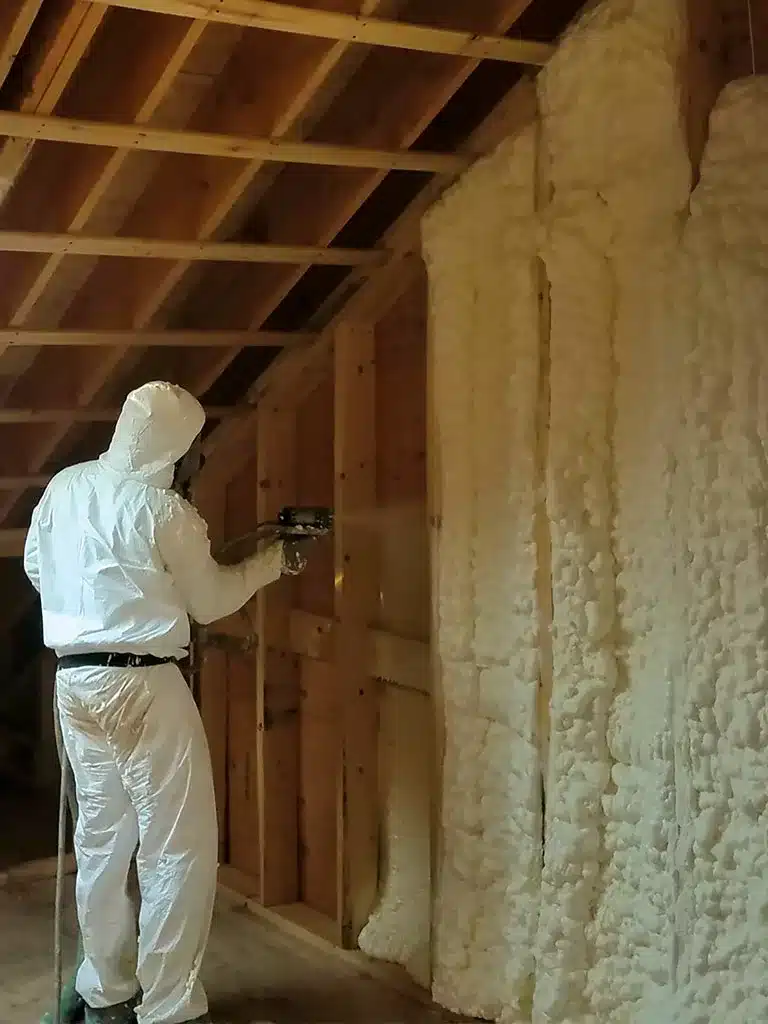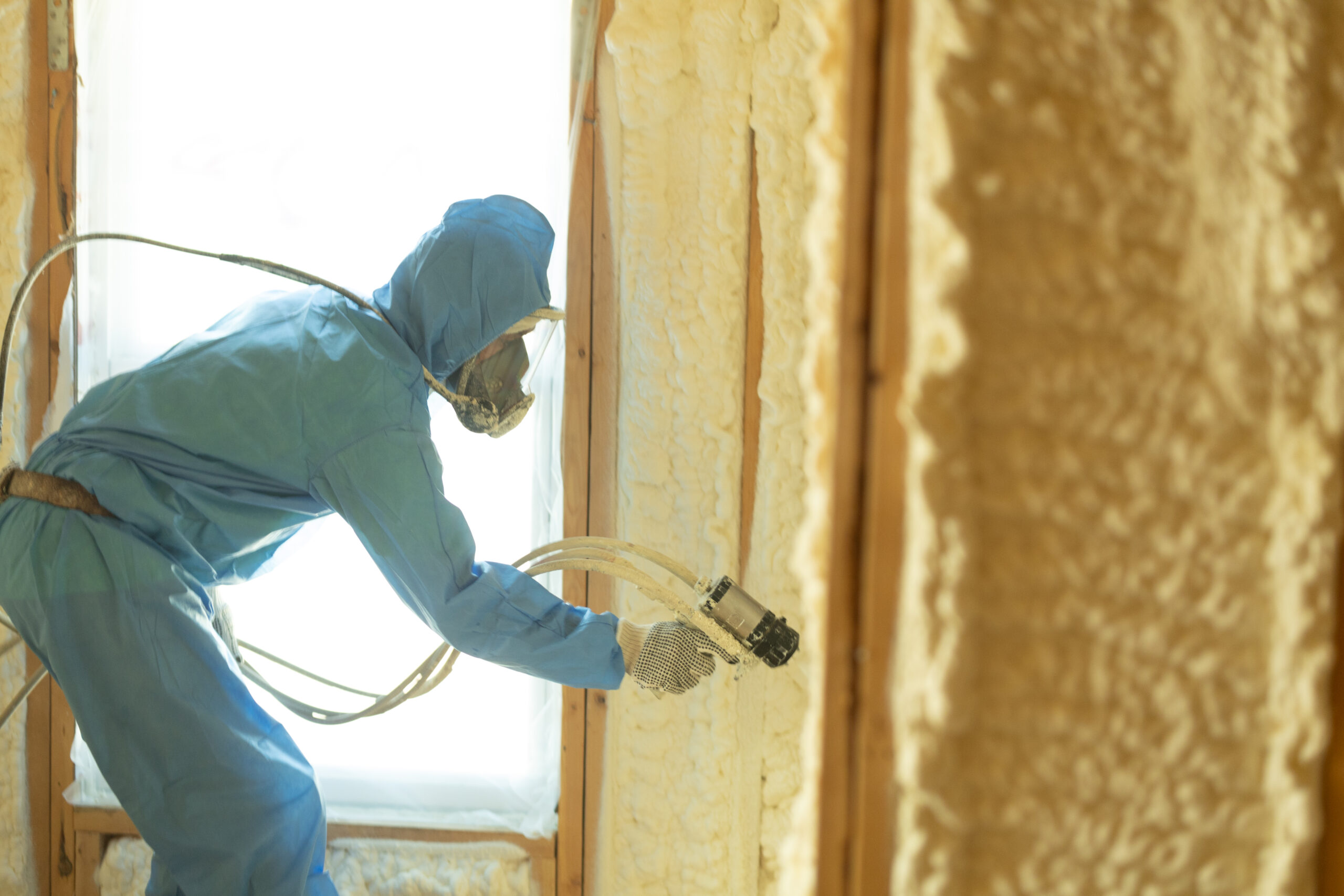Typical Myths Regarding Spray Foam: Debunking the Misconceptions
Typical Myths Regarding Spray Foam: Debunking the Misconceptions
Blog Article
Spray Foam: The Ultimate Solution for Air Sealing and Insulation
Spray foam insulation has actually become a leading remedy for efficient air securing and thermal insulation, providing an one-of-a-kind combination of residential properties that establish it apart from traditional techniques. Its capacity to expand and load spaces makes it specifically reliable in stopping air leakage, which can significantly affect power effectiveness. Recognizing the complete extent of its advantages, setup processes, and comparisons with various other insulation kinds is critical for making educated decisions. As we check out these aspects, the implications for both new building and constructions and retrofits become significantly substantial. What factors should affect your choice?
What Is Spray Foam?
Spray foam is a functional insulation material that combines the concepts of air securing and thermal resistance to boost energy effectiveness in buildings. Composed mostly of polyurethane or various other similar substances, spray foam is used as a liquid that broadens upon contact with surface areas, producing a solid, continuous layer of insulation. This special home enables it to fill up spaces, fractures, and voids that standard insulation materials may overlook, giving an exceptional air seal.
There are two primary types of spray foam: open-cell and closed-cell. Open-cell spray foam is lighter and a lot more flexible, offering superb sound absorption and a reduced R-value per inch - Spray Foam. On the other hand, closed-cell spray foam is denser, giving a greater R-value, moisture resistance, and added structural honesty to constructing components
The application process typically entails specialized tools, ensuring a smooth application that complies with numerous substrates, consisting of concrete, timber, and metal. This versatility makes spray foam appropriate for both brand-new building and constructions and retrofitting existing frameworks. Its capacity to develop an airtight obstacle dramatically adds to reducing power usage and enhancing interior air top quality, therefore making it a favored choice amongst building contractors and house owners alike.
Advantages of Spray Foam Insulation
Among one of the most considerable advantages of spray foam insulation is its outstanding capacity to develop a continual air obstacle, which properly reduces power loss. Unlike traditional insulation products, spray foam increases to fill up gaps and fractures, making sure that air leakage is considerably lowered. This characteristic not only improves power effectiveness yet additionally brings about lower utility costs with time.
Additionally, spray foam insulation gives exceptional thermal resistance, adding to a more secure interior setting. Its high R-value per inch permits efficient insulation in restricted areas, making it perfect for attics, wall surfaces, and crawl areas. Additionally, the moisture-resistant residential properties of spray foam help protect against mold and mildew and mold growth, promoting healthier living conditions.
Another essential advantage of spray foam insulation is its sound-dampening top qualities (Spray Foam). It properly minimizes sound transmission in between spaces, creating a quieter and a lot more comfy home setting. The longevity of spray foam likewise stands out, as it does not sag or clear up over time, keeping its efficiency throughout its life-span
Exactly How Spray Foam Works
Comprehending just how spray foam insulation functions is essential for valuing its performance in air securing and thermal resistance. Spray foam insulation includes 2 key components: isocyanate and polyol resin. When these components are mixed, they undertake a chain reaction that creates the product to increase rapidly, developing a thick foam that fills up gaps, splits, and cavities.
As the foam broadens, it sticks to surface areas, creating an airtight seal that dramatically decreases air seepage. This characteristic makes spray foam insulation extremely effective at preventing drafts and moisture penetration, which can result in energy loss and damage with time. In addition, the closed-cell variation of spray foam uses superior thermal resistance as a result of its stiff framework, successfully minimizing warm transfer.
The one-of-a-kind properties of spray foam enable it to comply with uneven surfaces, making sure comprehensive insurance coverage and a seamless obstacle. Consequently, spray foam insulation not only boosts energy performance however additionally adds to improved interior air high quality by decreasing the build-up of allergens and pollutants. Ultimately, understanding the auto mechanics behind spray foam emphasizes its function as a superior choice for insulation and air sealing in both commercial and residential applications.
Installment Process Introduction

Before setup, the room should be properly cleaned and prepped, ensuring that surface areas are cost-free from dust, particles, and dampness. This step is crucial because contaminants can jeopardize adhesion and overall efficiency. As soon as the area is prepared, the application involves visit the site blending the two elements of the spray foam, which expands upon contact and loads voids successfully.
Educated professionals ought to carry out the installation, utilizing customized tools to make sure consistent insurance coverage and optimal density. Safety precautions, including using safety gear and making sure appropriate ventilation, are this contact form critical throughout this procedure. After application, the foam typically cures rapidly, developing a solid obstacle that enhances power efficiency.
Comparing Spray Foam to Traditional Insulation
When examining insulation options, spray foam insulation stands out in contrast to typical materials such as fiberglass and cellulose. Unlike fiberglass and cellulose, which can allow air seepage, spray foam expands upon application, filling up gaps and gaps to create an airtight seal.
In addition, spray foam offers a greater R-value per inch than typical insulation kinds, using even more efficient thermal resistance in a thinner account. This particular is particularly advantageous in rooms with restricted dental caries deepness. Spray foam is resistant to wetness and mold development, which can be a considerable concern with cellulose and fiberglass, specifically in moist settings.
Nonetheless, spray foam insulation normally lugs a higher in advance price than its traditional counterparts. Home owners should weigh this first investment against lasting power savings and performance benefits. Ultimately, while both insulation kinds offer their objective, spray foam emerges as an advanced option for contemporary insulation demands, especially in terms of air securing and thermal effectiveness.

Final Thought
In summary, spray foam insulation represents an extremely efficient option for attaining optimum air securing and thermal resistance. Its unique residential or commercial properties, including moisture resistance and sound dampening, make it suitable for various applications in both brand-new constructions and retrofitting jobs (Spray Foam). The first expenses may be greater contrasted to traditional insulation materials, the long-term advantages, such as substantial energy financial savings and improved indoor air top quality, validate the investment and highlight its value in modern-day building methods.
Spray foam insulation has actually arised as a leading remedy for click this effective air securing and thermal insulation, supplying a special combination of buildings that set it apart from standard methods.Spray foam is a functional insulation material that integrates the concepts of air securing and thermal resistance to boost power effectiveness in structures.When assessing insulation options, spray foam insulation stands out in comparison to standard materials such as fiberglass and cellulose. Ultimately, while both insulation kinds serve their purpose, spray foam emerges as an extra innovative remedy for modern-day insulation demands, specifically in terms of air sealing and thermal efficiency.
In recap, spray foam insulation stands for a very effective solution for accomplishing optimum air securing and thermal resistance.
Report this page